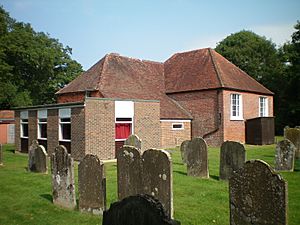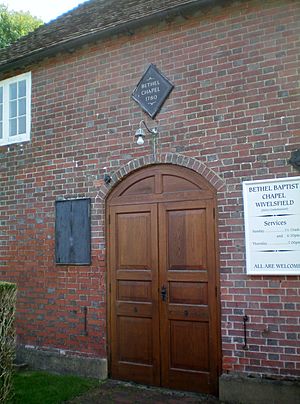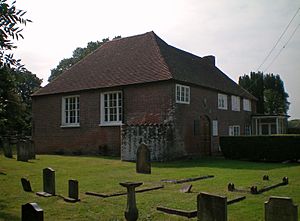Bethel Strict Baptist Chapel, Wivelsfield facts for kids
Quick facts for kids Bethel Baptist Chapel |
|
|---|---|
| Bethel Strict Baptist Chapel | |
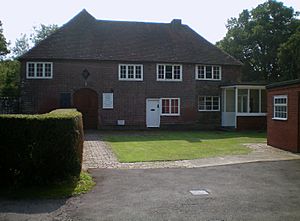
The chapel from the north
|
|
| 50°57′46″N 0°05′43″W / 50.9627°N 0.0952°W | |
| Location | Ditchling Road, Wivelsfield, East Sussex RH15 0SJ |
| Country | England |
| Denomination | Baptist |
| Churchmanship | Strict Baptist |
| History | |
| Former name(s) | Wivelsfield Baptist Meeting House |
| Status | Chapel |
| Founded | 1763 |
| Founder(s) | Henry Booker |
| Architecture | |
| Functional status | Active |
| Heritage designation | Grade II |
| Designated | 3 February 1977 |
| Style | Vernacular |
| Groundbreaking | 1780 |
| Completed | 1780 |
Bethel Baptist Chapel is a historic church building in the village of Wivelsfield, located in East Sussex, England. It is a place of worship for a group called Strict Baptists. This church was started way back in 1763 by people who left another church in nearby Ditchling. They were inspired by a famous preacher named George Whitefield.
Even though some people went back to their old church, the new group grew strong under the leadership of Henry Booker. The beautiful chapel you see today was built in 1780. It has been used by the Strict Baptist community ever since. Over the years, members from this chapel even helped start other churches in Sussex. Today, Bethel Baptist Chapel is recognized as a Grade II Listed building, which means it's an important historic place.
The Chapel's Story
Throughout Sussex, a county in southeast England, many different Christian groups have worshipped alongside the main Church of England for centuries. This started after 1662, when a law allowed more religious freedom. People who worshipped outside the Church of England were called Nonconformists or Dissenters. The area around Lewes, a major town in East Sussex, was a popular spot for these groups, especially Baptists.
Ditchling, a village close to Lewes, also had several churches besides the main Anglican one. In fact, in 1780, the local vicar said Ditchling was "noted for Dissenters of almost all denominations." A type of Baptist church, called a General Baptist chapel, was started there in the 1730s. It served people from many villages around central Sussex.
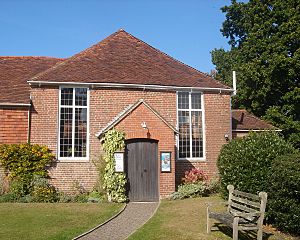
Over time, some General Baptist churches in the area started to change their beliefs, becoming more Unitarian. This change didn't make everyone happy. At the Ditchling chapel, some members decided to leave and start a new church in Wivelsfield.
In 1762, Henry Booker, a bricklayer from Ditchling, went to Brighton to hear the famous preacher George Whitefield. Whitefield's sermon deeply affected Booker, and he changed his religious views. These new beliefs didn't fit with the Ditchling chapel, which was mostly Unitarian by then. Booker was asked to explain his beliefs to 15 ministers. He felt the Ditchling church was no longer a "true Christian Church" for him. So, on October 20, 1762, he was asked to leave.
Right away, Booker moved to nearby Wivelsfield. He brought several members from the Ditchling church with him. Together with some Baptist friends in Wivelsfield, he registered a house called Fanners as a place to worship. In 1763, their new church was officially formed as a Particular Baptist chapel. John Simmonds became its first pastor in 1764.
In 1765, there was another disagreement, and more than half the church members left. In 1768, Henry Booker became the full-time pastor. The meetings then moved to his house at Bankside Farm. Booker also helped a group of Baptists in Brighton start their own church, the Salem Baptist Chapel.
The Wivelsfield church joined the Kent and Sussex Baptist Association in 1779. The next year, in 1780, a new chapel building was constructed on land next to Bankside Farm. It was first called Wivelsfield Baptist Meeting House, but soon became known as Bethel Chapel.
Henry Booker passed away in 1799. For a while, the chapel had different pastors. The church grew at first, even needing an extension. But after a few years, the number of members dropped, and the chapel closed for several years.
The chapel reopened in 1837. A pastor named Thomas Baldock, who started in 1840, helped the church become strong again. He moved to Wivelsfield from another Baptist village, and many of his family members followed. The Baldock family has been important in Wivelsfield ever since.
Bethel Chapel has not changed much since it was built. The graveyard around it opened in 1780. A house was built next to the chapel at the same time. It used to be for the pastor but is now used as a baptistery (a place for baptisms) and a hall. A newer extension was added in 1977.
Bethel Baptist Chapel was officially named a Grade II Listed building on February 3, 1977. The attached baptistery also received Grade II listed status on the same day. Wivelsfield village has two other historic churches: St Peter and St John's Church, which is much older, and Ote Hall Congregational Chapel, founded in 1778.
Bethel Chapel is officially registered for worship.
What the Chapel Looks Like
Bethel Chapel is a simple, traditional building that has been extended a few times. People have described it as "a quaint and interesting place" with a "quiet and unassuming elegance." The building has different heights and is mostly two stories tall, shaped like the letter L. One part of the building is covered with weatherboarding (overlapping wooden boards). The roof is hipped (sloping on all four sides) and covered with tiles.
The oldest part of the chapel is the northern section and the small house attached to the west end. These two parts originally formed a simple rectangle. In the 19th century, an extension was added, making the chapel bigger inside.
There are three entrances that are still used. The main doorway has a curved arch and an original wooden door with panels. The other two entrances have straight tops and simple wooden doors. You can still see signs of another entrance that used to be there. Above the main door, there's a stone showing the year 1780. The chapel also has four windows, each made up of three parts.
Inside, there's a wooden gallery that goes around the north end. A clock made in Lewes is on the front of the gallery, which also has wooden panels. Windows above the main entrance let light into the gallery. The benches in the gallery have open backs and are original. However, the seats on the ground floor were replaced in the 19th century. You can also see a decorative plaster cornice (a molding along the top of a wall) inside. The pulpit, where the minister preaches, was added in the early 19th century and also has decorative designs.
In the graveyard, there are memorials for Henry Booker, who died in 1799, and his wife Sarah. Inside the chapel, there's an oil painting of Booker. It says he was the "First preacher of the Gospel at Bethel Chapel, Wivelsfield, Sussex, 1780, died 22 May 1799 aged 69."
See also
- List of places of worship in Lewes (district)
- List of Strict Baptist churches



